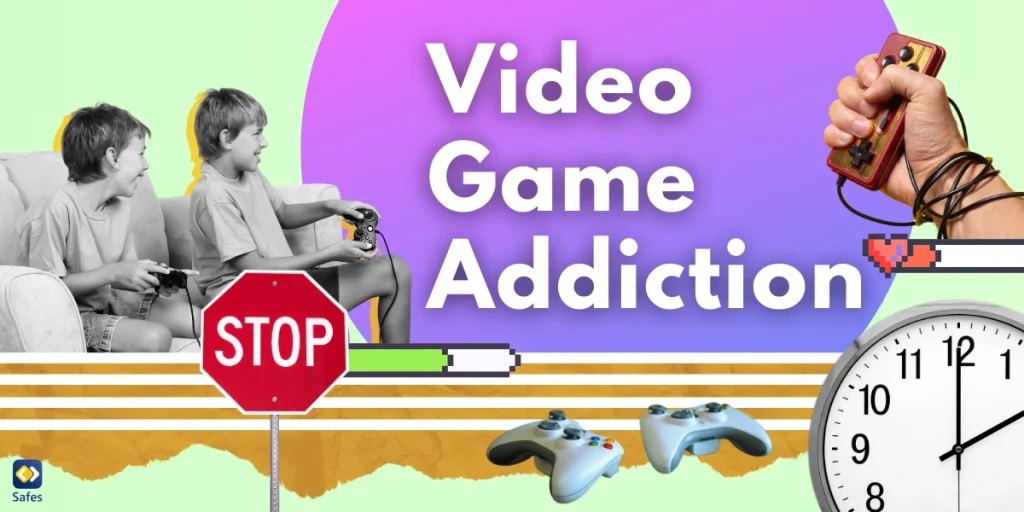Video game addiction has become a growing concern for many parents today. According to AddictionHelp, recent research suggests that video game addiction affects between 1.7% and 10% of the American population. With the increasing popularity of games that captivate children for hours on end, it’s important to understand the negative effects of video games and the impact this can have on young minds. An example of video game addiction might include a child who spends every free moment gaming, at the cost of other activities and relationships.
Download and Start Your Free Trial of the Safes Parental Control App
Video game addiction is defined as the compulsive or uncontrolled use of video games, which results in negative impacts on various areas of life, such as social relationships, academics, and physical health. It often involves excessive gaming, neglect of other activities, and an inability to reduce playing time.
Parents are understandably worried about how gaming addiction affects their children’s health, social life, and academic performance. This blog post is here to help. We’ll explore seven necessary steps that parents can take to manage and overcome video game addiction and help their children regain balance and develop healthier habits.
1- Recognize the Signs of Video Game Addiction
Video game addiction often starts with subtle changes in behavior that can quickly become more noticeable. Recognizing the signs of video game addiction is the first step in addressing the issue before it becomes more serious. Children addicted to video games may exhibit symptoms like withdrawal from social activities, mood swings, and a persistent focus on gaming over other interests.
In particular, watch out for signs of irritability when they can’t play their favorite games or changes in sleep patterns due to late-night gaming. Viral games that are popular among their peers can also contribute to addictive behavior as children feel pressure to keep up with their friends.
The earlier these signs are identified, the more manageable they become. Once you see these signs, it’s important to act sooner rather than later to prevent the addiction from taking a deeper hold.

2- Understand the Root Causes
Understanding the causes of video game addiction can provide valuable insights into how best to address it. Many children turn to video games as a way to cope with stress, relieve boredom, or even fulfill social needs that aren’t being met elsewhere.
By understanding why your child is drawn to video games, you can better address those needs in a healthier way. This might include encouraging alternative ways to reduce stress, helping them find other social opportunities, or simply providing more variety in their daily routines.
3- Set Clear and Healthy Boundaries
One of the most effective ways to manage video game addiction is by setting clear and healthy boundaries. Establishing daily or weekly screen time limits can help your child understand that gaming is an activity that should be enjoyed in moderation. It is also helpful to highlight the advantages of video games for personal skills when played responsibly, so your child doesn’t feel that gaming is entirely negative.
Setting clear and healthy boundaries is crucial for managing video game addiction. This can include creating limits on gaming time and establishing rules that fit well within the family’s schedule. Consistency is key, and involving children in creating these rules can improve adherence and reduce resistance.
Consider creating a family agreement around gaming, which can include input from your child. This will give them a sense of ownership over the rules and increase their likelihood of sticking to them. Setting achievable and consistent rules, like “no gaming during meals,” can also go a long way in creating balance.
4- Encourage Alternative Activities
To break free from video game addiction, it’s important to offer children alternative activities that they find equally fulfilling. Redirecting energy into sports, music, art, or other interests can provide a new sense of purpose and reduce reliance on video games.
Additionally, when selecting games for your child, prioritize safe games for kids that promote creativity, problem-solving, and learning rather than those with addictive mechanics or violent content. By choosing age-appropriate and educational games, you can ensure that gaming remains a positive and enriching experience for your child.
Some of the most addictive video games are designed to hold attention for long periods, which makes finding other activities crucial. For example, getting involved in a local soccer team or taking up a musical instrument can provide an engaging challenge that doesn’t involve screens. If your child enjoys gaming, consider introducing them to age-appropriate options like PS5 games for kids, Nintendo Switch games for kids, and Xbox games for kids that promote creativity, problem-solving, and cooperative play. Choosing games with positive themes can help create a healthier gaming experience while balancing screen time with other activities.
“By encouraging your child to try new hobbies, you can help them discover interests that replace the urge to play video games constantly. Engaging them in household chores games, like turning cleaning into a challenge or a timed race, can make responsibilities more enjoyable while keeping them active and away from screens.
5- Create a Positive Home Environment
A supportive and positive home environment can make a big difference in managing video game addiction. Encouraging open communication and showing empathy towards your child’s feelings helps them feel understood rather than judged.
A positive home environment is one where children feel understood, supported, and engaged in non-screen activities. Encouraging open discussions about their interests and fostering family traditions without screens can help children see that there are enjoyable experiences beyond video games.
Plan family activities that do not involve screens, such as playing family board games, going on outdoor adventures, or even cooking a meal together. Introducing your child to the best family games, or cooperative video games with positive themes, can provide a fun way to bond while reducing their reliance on solo gaming sessions.

6- Monitor and Guide, Not Control
It’s important to strike a balance between monitoring gaming habits and being too controlling. Children often respond negatively to overly restrictive measures, which can lead to secretive behavior or resentment. Instead, focus on being a guide who supports rather than dictates their habits.
Using apps to track screen time can be a helpful tool, allowing you to understand your child’s habits and make adjustments where needed. However, remember that violent video games and aggression can sometimes be linked, so it’s also important to discuss the type of games your child is playing.
Maintaining trust and an open line of communication will make it easier to set limits without making your child feel overly controlled.
7- Seek Professional Help When Needed
In some cases, managing video game addiction at home might not be enough. If you notice that your child’s gaming habits are severely affecting their daily life and they’re unable to reduce screen time despite your best efforts, it may be time to seek professional help.
Consulting therapists or counselors who specialize in behavioral issues can provide valuable support and guidance for your family. There are also support groups that can offer additional resources for parents and children who are struggling with similar issues.
Recognizing when the situation is beyond your control is not a failure—it’s a required step towards your child’s well-being.
Safes: Tools for Managing Video Game Addiction
Parental control apps can be incredibly helpful tools when dealing with video game addiction. Our product, Safes, is designed to help parents manage screen time, set appropriate boundaries, and ensure their child’s digital activities are safe and healthy.
Consider trying our free trial to see how Safes can work for your family. Downloads are available on both iOS and Android platforms, giving you an accessible way to regain control over your child’s gaming habits.
Final Thoughts on Managing Video Game Addiction
Video game addiction can be a challenging issue for parents, but with the right strategies, it’s possible to help your child regain control. By recognizing the signs early, understanding the causes, setting boundaries based on their age, and encouraging other activities, parents can make significant progress towards reducing their child’s reliance on video games.
Creating a positive home environment, monitoring gaming habits thoughtfully, and seeking professional help when needed are all essential steps in supporting your child. With a supportive approach, you can help your child overcome their video game addiction and develop a healthier relationship with technology.
Remember, every child is different, and progress may be gradual. Stay patient, stay hopeful, and know that change is possible with the right support and strategies.
Your Child’s Online Safety Starts Here
Every parent today needs a solution to manage screen time and keep their child safe online.
Without the right tools, digital risks and excessive screen time can impact children's well-being. Safes helps parents set healthy boundaries, monitor activity, and protect kids from online dangers—all with an easy-to-use app.
Take control of your child’s digital world. Learn more about Safes or download the app to start your free trial today!




